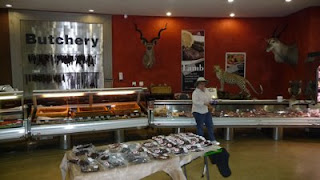My family had never traveled outside of the US, so I was a little surprised—but also very excited—to hear they had planned to visit me in Namibia. More than a year and a half had passed since I said goodbye to my mom, dad and brother, and while they’ve kept up with weekly phone calls and regular care packages (both of which I truly enjoy), there’s really no substitute for face-to-face family time.
Especially after so many months apart.
I’m not sure my too-tall dad expected to go directly from 20-some hours sitting in the too-small seat of a crowded airplane to two and a half hours navigating Namibian streets on the left-hand side of the road. But that’s exactly what he did. And while it may have taken him 60 kilometers to work up the nerve to pass a slow-moving Mac truck, I still think he handled it like a real trooper. It couldn’t have been easy.
The combination of jetlag, exhaustion, driving a stick on the other side of the street and unfamiliar surroundings seemed to throw him off—as it would anyone, I imagine. And while roads in Namibia are often almost empty, my dad faced his first day on the African roads alongside overloaded bakkies and buses of school kids trying to make it back in time for the start of term two. Whenever a car approached in the opposite lane, dad would flinch and veer onto the shoulder of the road. (This may explain the slightly deflated tires on the passenger side of the car.) And while his skills (or rather, lack of) left us all a bit nauseous, no one seemed happier than him to reach our final destination.
Sure, we were happy to have a meal and get some rest. But mostly, I think my dad was grateful to see streets that looked more like this one:
Empty.
We ate a quick dinner, placed a call to the airport about a piece of lost luggage, snapped the first family photo in over a year, and then went off to bed.
The following day we took it easy. We woke up late. We walked through the streets of Otjiwarongo. We visited the biggest grocery store this side of Khorixas.
And after lunch, we drove 40 kilometers outside of town to The Cheetah Conservation Fund. The research and educational center was established by American conservationist, Dr. Laurie Marker. It seeks to protect the most endangered cat in Africa by educating farmers about humane ways to protect their herds, and teaching young learners about the importance of cheetahs in Namibia’s ecosystem. In addition to housing cheetahs and educating youth, the Fund breeds cattle hounds for area farmers and uses its own land and herds to prove that by implementing some simple practices (dogs and donkeys among other things), cattle can thrive alongside cheetah. (At the moment, man poses the biggest threat to the cheetah’s survival. Farmers often kill the cats to prevent them from destroying their herds.)
My friend Nick, who happens to be a fellow PCV, recently began working for the Cheetah Conservation Fund. He scheduled a feeding to coincide with our visit. The Fund mostly tags and releases area cheetahs for research, but several of the cats that were elderly, injured or abandoned by their mothers still live on the property.
Our guide showed us around the grounds and the lab. Afterwards, we lined up for a feeding. Volunteers like Nick brought out huge bowls with five-pound hunks of raw donkey meat. The cheetahs anxiously paced their cages. One trap door shut. Another opened. And suddenly the fastest animal in the world lunged on its lunch. It was pretty incredible to see up close. 

Mealtime lasted only a couple of minutes. That’s all the time it took for these hungry cats to devour chunks of raw meat that were twice the size of their heads. But luckily, this wasn’t the end of our tour. After seeing where the Fund’s herding dogs were bread and trained, we boarded a game car and headed out to the open range where seven female cheetahs were allowed to roam mostly free. It was amazing to see these cats in their near natural habitat. It was the first time I’d seen a cheetah in Namibia. And also, the first time I’d seen one up so close. 
We were lucky to see the cage feedings, but even luckier to be inside the gates when the female cheetahs were called for supper. Unlike the other cats at the Conservation who take their food in tin tubs, these ladies were fed out in the open. Volunteers called the cats to eat, then once all were present, chucked the same donkey meat over a towering fence. The female cheetahs growled, pounced, and then hauled off to eat alone. 
It may not have been the wild, but we certainly got a sense of just how powerful these animals (and their jaws) truly are. I was happy to see them in action, but I definitely wouldn’t want to come between a cheetah and its meat.
^[]^ Gratis Nel lento esistere Pdf Epub
5 years ago



5 comments:
Great post! Can't wait to hear more about your visit with the fam. Love you!
Yay you guys!
<3 Leigh
nawrocki's in namibia! can't wait to hear more!
love you!
whoa! I love the part about your dad driving etc...I feel like I was kinda there!
xx
P.S. Your dad's likeness to Jim Boeheim is no joke.
Post a Comment